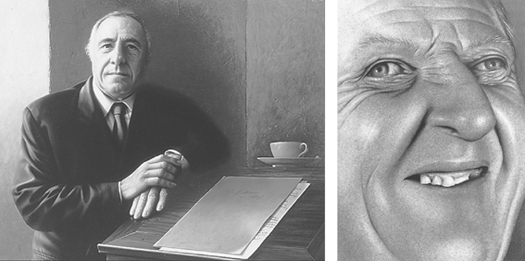
On the paintings of Jan Peter Tripp
The catalog of Jan Peter Tripp’s oeuvre today goes back more than a quarter of a century. It comprises works on a range of vastly differing scales, executed in pencil, charcoal, and drypoint, in watercolor, gouache, and grisaille, acrylics and oil, taken to the furthest limit of the possible and frequently, or so it appears to the observer, some way beyond it. The pictures from the first three or four years of Tripp’s career still clearly show the influence of surrealism, of the Vienna school of fantastic realists, and of photorealism, still embedded in the polemical strategies of 1968; but soon afterward, during the months spent as an artist in the regional psychiatric hospital at Weissenau near Ravensburg in 1973, this polemical trait disappears, to be replaced by a far more radical objectivity which, by simply representing life in all its manifestations, seeks to establish what gives rise to its particular evolution and expression. In this way, the art of portraiture becomes an exercise in pathography, no longer admitting of any distinction between what is generally known as the character of the individual and the deformations occasioned by the ordeals of work and mental suffering in the subject portrayed. If the paintings of the Weissenau asylum inmates may be understood as studies of the echoing void in the heads of humankind, then this is no less true of the late portraits and self-portraits, with their almost otherworldly sense of isolation. Even the most recent portraits of respected incumbents of positions of economic and political power have (without the slightest defamatory intention) a tortured self-consciousness and a slight air of derangement about

them, and so share a secret affinity with the definition, arrived at in Weissenau, of the human individual as an aberrant creature, forcibly removed from its natural and social environment. The obverse of this depiction, of a race growing ever more monstrous in the so-called process of civilization, are the deserted landscapes, devoid of all human presence, and in particular the still lifes, in which, far removed from the world of events, only the motionless objects are left to bear witness to the former presence of a strangely rationalistic species. Tripp’s still lifes are not primarily concerned with the skill and mastery of the artist, exercised upon a more or less random assemblage, but rather with the autonomous life of things—in relation to which we, as creatures in blind thrall to the world of work, find ourselves in a subordinate and dependent position. Since (in theory) things outlast us, they know more about us than we do about them; they bear their experience of us within them and are—in a literal sense—the book of our history lying open before us. In the father’s so-called Russian suitcase lie the shoes of the son;
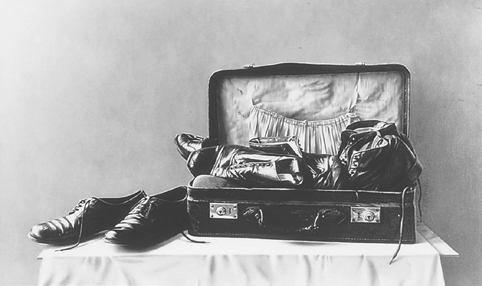
two dozen slates and a few faded scribblings evoke an entire vanished class of schoolchildren—images of the past, of the most mysterious aspects of a life. In Tripp’s work, more clearly than ever before, the nature morte represents the paradigmatic expression of what we leave behind. Looking at it, we become aware of what Maurice Merleau-Ponty, in L’Oeil et l’Esprit, has called “le regard préhumain,” for in such painting the role of the observer and the observed object are reversed. In gazing, the painter surrenders our all-too-superficial knowledge; things look across at us, unblinking, and fix us in their gaze. “Action et passion si peu discernables,” writes Merleau-Ponty, “qu’on ne sait plus qui voit et qui est vu, qui peint et qui est peint.”
Thinking about the work of Jan Peter Tripp, and the way in which, in it, the exact reproduction of reality achieves an almost unimaginable degree of precision, it is impossible to avoid the tiresome question of realism. On the one hand, because the first thing to strike anyone looking at a picture by Tripp is the apparently flawless accuracy of representation, and on the other, because, paradoxically, it is precisely this astounding facility which distorts the view of its true achievement. The perfect surface of the completed picture offers so little in the way of clues that even professional art criticism has scarcely anything meaningful to add to the lay utterances of astonished admiration. Such utterances are, moreover, typically made with (so to speak) an incredulous shake of the head, since the unquestioning admiration is in all likelihood tempered—particularly in the case of those critics schooled in the traditions of modernism, who tend on the whole to be largely ignorant when it comes to matters of technique—with the uneasy sensation of having been taken in by some kind of illusionist or confidence trickster operating with all manner of inscrutable sleights of hand. Indeed, not only does Tripp succeed in interpolating the third dimension into the surface of the painting, to the extent that, looking at it, one sometimes has the feeling one could step over the threshold and enter the picture itself; but the materials represented, too, the cypress black of young Marcel’s velveteen jacket, his
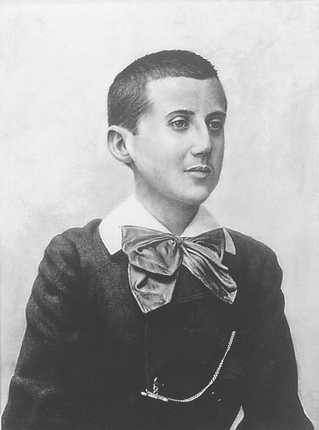
taffeta bow, the forty-one pebbles, and the white snow on the field, appear so truly real in the painting that one involuntarily reaches out a hand to touch it. Ernst Gombrich, in his comprehensive work on art and illusion, recalls the story Pliny relates of the two Greek painters Parrhasius and Zeuxis. Zeuxis, it is said, painted grapes in such a deceptively realistic manner that the birds tried to peck at them. Parrhasius then invited Zeuxis to his studio in order to show him his own work. When Zeuxis went to draw back the curtain in front of the picture to which Parrhasius led him, he discovered that it was not in fact real, but only painted. Gombrich goes on to explain how, in trompe l’oeil painting, the suggestive power of the picture and the expectation on the part of the viewer mutually reinforce each other, and he concludes the section with the remark that the most convincing trompe l’oeil he had ever seen “simulated” a broken pane of glass in front of the picture.

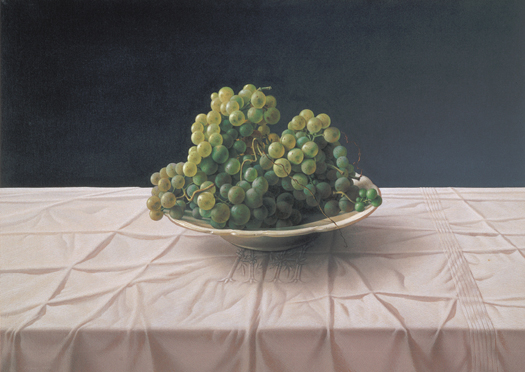
Well, in Tripp’s work we find both the grapes of Zeuxis and the broken pane of glass. And yet it would be wrong to regard him first and foremost as a virtuoso of trompe l’oeil painting. Tripp makes use of trompe l’oeil as just one technique among many, and always—as the watercolor Ein leiser Sprung [A Little Crack(ed)] illustrates—with the closest possible link to the subject of the painting.
Trompe l’oeil is a manner of painting capable, with relatively limited means—whether by a certain organization of perspective, or an astute deployment of light and shade—of conjuring up the so-called effet du réel as it were from nothing. Its most adept practitioners were, of course, the quadratisti of the baroque era, who traveled all over Austria and Bavaria conferring upon various not particularly impressive intérieurs an illusion of palatial grandeur by painting the walls with whole series of colonnades, and grandiose domes on the ceilings. The whiff of trickery and inconsequentiality, which attaches to any artistic practice whose effects can be indiscriminately deployed, later—at least since the dawn of photography and the beginnings of the modernist era which it ushers in—came to be extended to representational painting as a whole. For this reason, the idea that radically exposed artistic positions might nowadays be arrived at just as readily through representational as nonrepresentational art is, for an art critic, virtually inconceivable; the more so as photo- or hyperrealism, with the tendency to reification implicit in its naturalistic mode of depiction, very rapidly arrived at the limit of its artistic possibilities.
That Tripp’s work is—almost inevitably—discussed in connection with this virtually outmoded movement is, then, the result of a false association. The one thing that seems to me worthy of note is the—implicit—suggestion that the essence of a painting by Jan Peter Tripp lies not in what one might assume to be the purely objective and affirmatory quality of its identical reproduction of reality (or the latter’s photographic image)—that quality which is without fail admired by each and every viewer—but rather in the far more subtle ways in which it deviates and differs from it. The photographic image makes a tautology of reality. When Cartier-Bresson goes to China, writes Susan Sontag, he shows that there are people in China and that these people are Chinese. What may be true of photography, though, is not necessarily applicable to art. The latter depends on ambiguity, polyvalence, resonance, obfuscation, and illumination—in short, the transcending of that which, according to an ineluctable law, has necessarily to be the case. Roland Barthes saw in the—now omnipresent—man with a camera an agent of death, and in photographs something like the relics of life continually giving way to death. Where art differs from such a morbid affair is in the fact that the proximity of life to death is its subject, not its obsession. Art deploys the deconstruction of outward appearances as a means of countering the obliteration, in endless series of reproductions, of the visible world. Accordingly, Jan Peter Tripp’s paintings, too, have a consistently analytic quality rather than a synthesizing one. The photographic raw material which they take as their starting point is painstakingly modified. Artificial distinctions between focus and out-of-focus effects are dissolved, additions and subtractions made. Something may be moved to another place, foreshortened, or rotated a fraction out of kilter. Tonal shades are altered, and from time to time those happy accidents occur which unexpectedly give rise to a system of representation directly opposed to reality. Without such interventions, deviations, and differences, the most perfect re-presentation would be devoid of all thought or feeling. What is more, looking at Tripp’s pictures one would do well to bear in mind Gombrich’s lapidary statement that even the most meticulous realist can accommodate only a limited number of marks in the allotted space. “And though he may try,” writes Gombrich, “to smooth out the transition between his dabs of paint beyond the threshold of visibility, in the end he will always have to rely on suggestion when it comes to representing the infinitely small. While standing in front of a painting by Jan van Eyck we … believe he succeeded in rendering the inexhaustible wealth of detail that belongs to the visible world. We have the impression that he painted every stitch of the golden damask, every hair of the angels, every fiber of the wood. Yet he clearly could not have done that, however patiently he worked with a magnifying glass.” In other words, the creation of a perfect illusion depends not only upon a vertiginous degree of technical ability, but ultimately upon the intuitive channeling of a breathless state in which the painter himself no longer knows whether his eye still sees or his hand still moves.
The recurring experience of a state of utmost concentration in which the breath grows ever shallower, the silence ever greater, the limbs gradually grow numb and the eyes grow dim, brought death into the paintings of Jan Peter Tripp. Unmistakably present in the early studies of bones and skulls, in later works it tends to lie concealed within the ominous-looking objects, in the faces of those portrayed, in the crack in the glass, the hermetic form of the pebbles, or the portrait of Kafka at fifty. In order to discover it, the painter had to venture across the border. On the way to the other side, too, was the dormouse discovered one morning lying on the doorstep. Although it is said that one should paint the dead quickly, surrounded by the chloroform stench of decomposition Tripp took seven days over the picture in which the silent message of this unexpected guest is preserved.
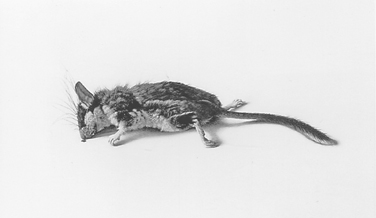
On the seventh day, there was one final tiny movement in the long since lifeless body, and a drop of blood the size of a pinhead appeared at the nostril. That was the true end. Nestling in nothingness, with neither ground nor background, the creature hovers now, its bat ears extended, through thin air. The black patch of fur around its eyes is reminiscent of a mourning band, or an eye mask worn by a sleeping passenger on a summer night’s flight over the North Pole. We are such stuff / as dreams are made on; and our little life / is rounded with a sleep.
The longer I look at the paintings of Jan Peter Tripp, the more I realize that beneath the surface illusionism there lurks a terrifying abyss. It is, so to speak, the metaphysical underside of reality, its dark inner lining. This hidden lining is revealed in a series of flower paintings, only recently begun, which despite their high degree of realism leave botanical illustration far behind. The flowers, which originally were to have been painted in the full glory of their natural colors, have become silent grisailles in which only the ghostliest trace of color remains. They are as if disembodied, trapped in the porcelain stillness of death. All of them bear women’s names and as such are of another kind. Yet their flamboyant, divalike forms still retain a pale reflection, faded almost to nothing, of organic living nature. In the painting of the green grapes, too, these latter represent one last sign of life. A strangely ceremonial, emblematic style governs the composition. The dark background, the white linen cloth with the embroidered monogram—already we begin to sense that it is spread out not for a wedding breakfast, but on a bier or catafalque. And what is the business of painting in any case but a kind of pathological investigation in the face of the blackness of death and the white light of eternity? This extreme contrast of light and dark recurs on a number of occasions, for example in the checkerboard pattern of the floor tiles in the Belgian billiard picture from Tongres, which not coincidentally seems to suggest that in any given frame the
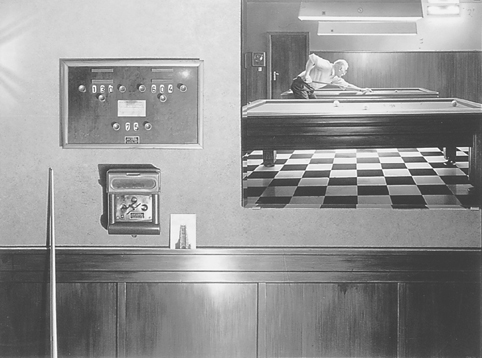
painter is embarking upon a game of chance in which one false move risks losing everything. In one of Tripp’s earliest paintings, the “kobaltblaue Krapplackkugel” [cobalt blue madder ball] is already rolling away toward a nocturnal vanishing point on the other side, and in each of the pictures that follow, the most intricate chess moves, circumventions, and evasions are played out back and forth between life and death: ’tis all a Chequer-board of Nights and Days / Where Destiny with Men for Pieces plays / Hither and thither moves, and mates, and slays / And one by one, back in the Closet lays.
Closely bound up with the theme of death is that of time passing, time past and lost time, which in Jan Peter Tripp’s pictures is suspended—just as in Proust—as ephemeral moments and constellations are preserved from the passage of time. A red glove, a burnt-out match, a pearl onion on a chopping board: these objects contain the whole of time within themselves, as it were redeemed forever by the painstaking, impassioned precision of the artist’s work. The aura of memory which surrounds them lends them the quality of mementos: objects in which melancholy is crystallized. An interior from La Cadière d’Azur shows a whitewashed wall
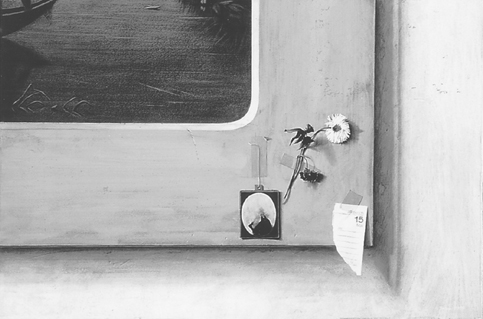
and the corner of a reproduction in oils, black with age, on which it is just possible to make out the motif of a boating trip across the water. On the wide plaster frame of the print—disguised to look like a mount—is fastened a miniature painted on ivory, a bust in the truest sense of the word, since the face of the subject is so scratched away as to be unrecognizable, and only the head and blue-uniformed shoulders of the unknown hero can be seen. Also attached to the frame is a small bunch of dried flowers (it immediately reminded me of the garland which Karoline von Schlieben wove with Heinrich von Kleist on the Brühlsche Terrasse in Dresden on the sixteenth of May 1801, a photograph of which has survived), as well as a scrap of paper torn from a diary bearing the date of the fifteenth of May—the painter’s birthday.
Time lost, the pain of remembering, and the figure of death are here assembled like mementos in a shrine to remembrance, quotations from the painter’s own life. Remembrance, after all, is in the end nothing other than a quotation. And the quotation interpolated into a text or an image forces us, as Eco writes, to revisit what we know of other texts and images, and reconsider our knowledge of the world. That, in turn, requires time. In taking it, we enter upon narrated time and cultural time. Let us attempt, by way of conclusion, to demonstrate this with the painting entitled La Déclaration de guerre, measuring 370 × 220 cm, in which an elegant pair of ladies’ shoes is to be seen upon a tiled floor. The pale blue and off-white pattern on the tiles, the gray lines of the grouting, the diamond pattern cast by the leaded light of the window
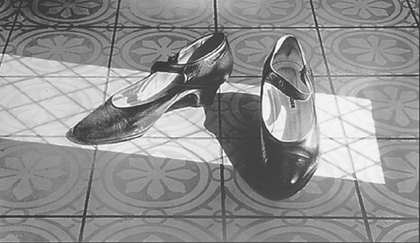
across the central portion of the picture, in which the black shoes stand between two areas of shadow; all this taken together produces a geometric pattern of a complexity which is incapable of expression in words. From a combination of this pattern—illustrating the intricacy of the various proportions, relationships, and interlocking connections—and the mysterious pair of black shoes, there arises a kind of picture puzzle that the observer, knowing nothing of the previous history, will scarcely be able to solve. Who was the woman the shoes belonged to? Where has she gone? Do the shoes now belong to someone else? Or are they, in the end, simply a paradigm for the fetish which the painter is compelled to make of everything he paints? It is difficult to say more about this picture than that notwithstanding its imposing scale and deceptive simplicity, it remains locked in the most intimate private sphere. The shoes give nothing away. Two years later, however, the painter brings his enigmatic picture at least a little further into the open. In a work of significantly smaller format (100 × 145 cm), the large picture reappears, not just as a quotation but as a mediating element of the painting. Filling the upper two-thirds of the canvas, it is evidently now hanging in its rightful place, and in front of it, in front of the Déclaration de guerre, perched sideways on a mahogany chair with white upholstery, a woman with flaming red hair sits with her back to the observer. She is smartly dressed but still gives the appearance of someone weary at evening from the burdens of the day. She has removed one of her shoes—the same shoes as the ones she is gazing at in the large picture.
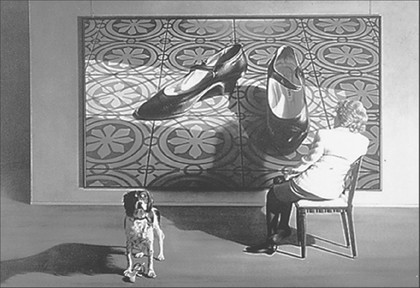
Originally, so I have been told, she was holding this one shoe in her left hand, then it was placed on the floor to the right of the chair, and finally it vanished altogether. The woman wearing one shoe, alone with the mysterious declaration of war—alone, that is, apart from the faithful dog at her side, who, however, is not in the least interested in the painted shoes but gazes straight ahead out of the picture and looks us directly in the eye. An X-ray would show that previously he was standing in the middle of the picture. In the meantime, he has been on a journey and has retrieved a kind of wooden sandal from the fifteenth century, or, as the case may be, from the wedding portrait which hangs in the National Gallery in London, painted by Jan van Eyck in 1434 for Giovanni Arnolfini and his wife in morganatic “left-handed” marriage, Giovanna Cenami, in token of his witness to the union. “Johannes de Eyck hic fuit,” it says on the frame of the circular mirror in which
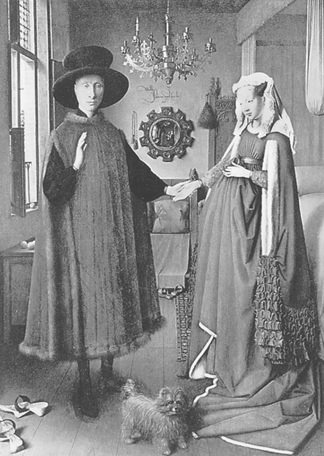
the scene can be seen again, in miniature, from behind. In the foreground, near the bottom-left-hand edge of the painting, lies the wooden sandal—that strange piece of evidence—next to a small dog who has somehow strayed into the picture, probably as a symbol of marital fidelity. The red-haired woman, who in Jan Peter Tripp’s painting is meditating on the fate of her shoes and an inexplicable loss, has no idea that the revelation of the secret lies behind her—in the form of an analogous object from a world long since past. The dog, bearer of secrets who leaps easily over the dark abysses of time, because for him there is no difference between the
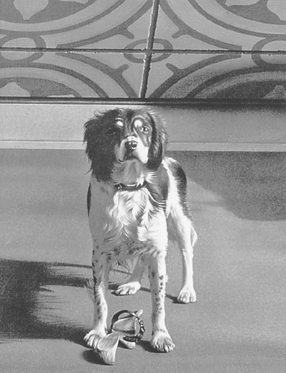
fifteenth and the twentieth centuries, knows many things better than we. His left (domesticated) eye looks straight at us; the right (untamed) eye has just a shade less light, seems remote and strange. And yet, we feel, it is precisely this eye in shadow which can see right through us.